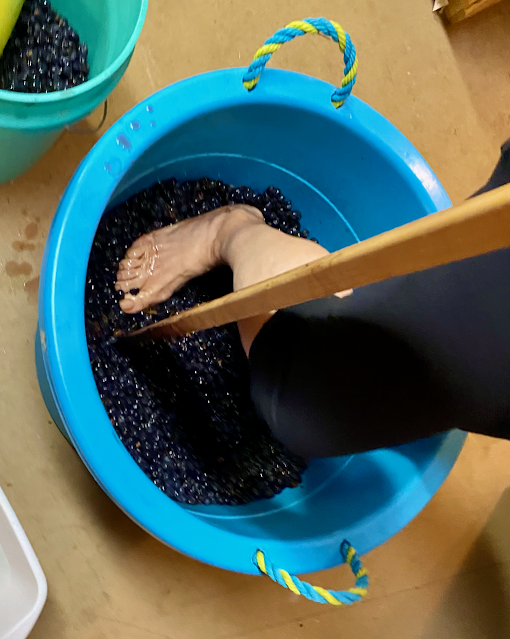I read an online article about pickling peppers in wine pomace. Pomace is the pressed wine skins & pulp left over after pressing the grapes.
It was the author's old family recipe, and it even said "A thick layer of disgusting mold will form on top, but don’t worry about that." Pretty rustic.
I thought, I can clean up that recipe -- find a way to make it in jars instead of in a bucket in the garage.
The recipe is clever because it does two things at once: first, the pomace and water ferment into wine vinegar, and second, the peppers get pickled in the vinegar.
It also gives you something to do with all that pomace besides fertilize the garden.
Pickled Peppers in Homemade Wine/Vinegar Recipe
1.5 quart red or green peppers, cut into 1-2 inch pieces
water
85 g sugar
The procedure is easy. Mix the sugar with the wine pomace. Layer the pomace and the peppers into quart jars. I place the bottles in a secondary container to catch overflow, if any.
Put the jar lid on loosely. Periodically (daily at first) open the jar and press down the contents to displace air bubbles forming inside.
The liquid will extract flavor from the grapes and pomace, and make a wine. After time, this wine may convert to vinegar.
It might not too. Recall, we did not add any vinegar yeast, and the pomace carried in a large amount of wine yeast.
If not the peppers will be preserved in wine -- still not so bad.
Let this go at least a week. When it stops bubbling, I am going to put them in a refrigerator. If you don't have room in the fridge, it will probably keep a while on the counter with the jar sealed.
When time comes to eat this, pick out the peppers to eat. The pomace isn't going to taste very good.
October 16 Update -- The sugar and pomace have fermented into wine, and the peppers are now quite soft and wine infused. The wine is pretty harsh, so the peppers aren't really that pleasant to eat.
October 22 Update -- What a difference a week makes! I strained off the "wine" liquid, and removed the pomace to the trash. I put the wine-infused peppers in their own bottle, and they have a pepper & wine flavor. Good on top of hummus & toast -- not too much tho because the their pretty intense.
So next year, I think these would be better with a fleshier pepper like a poblano or even red bell pepper. I can't grow decent red bell pepper is my garden.
Wine pomace in a kimchi recipe! Now I need to try that. I'll put the pomace in a silk bag, and then in the cabbage blend.















